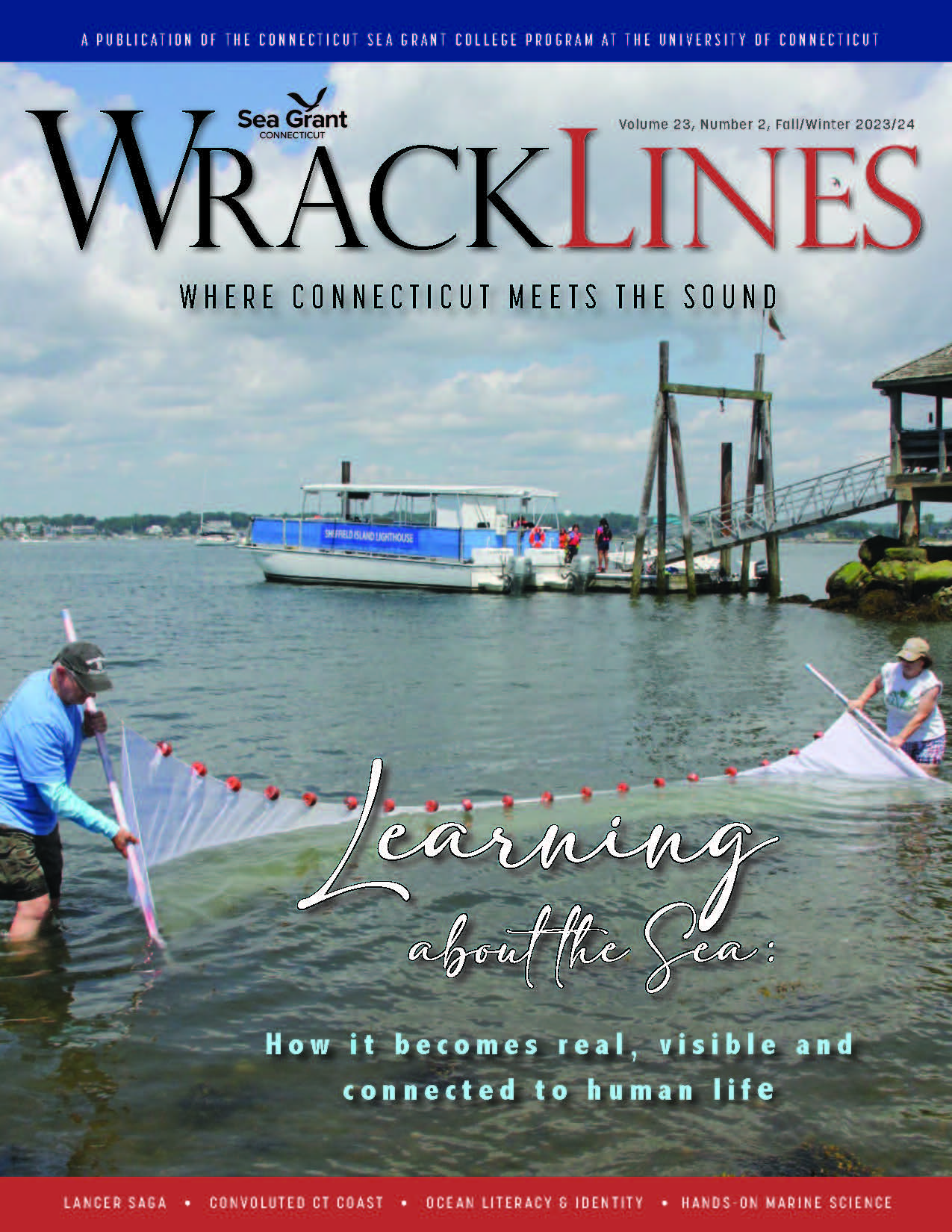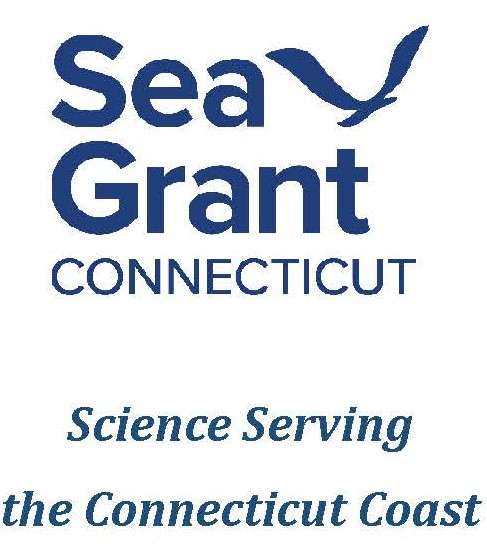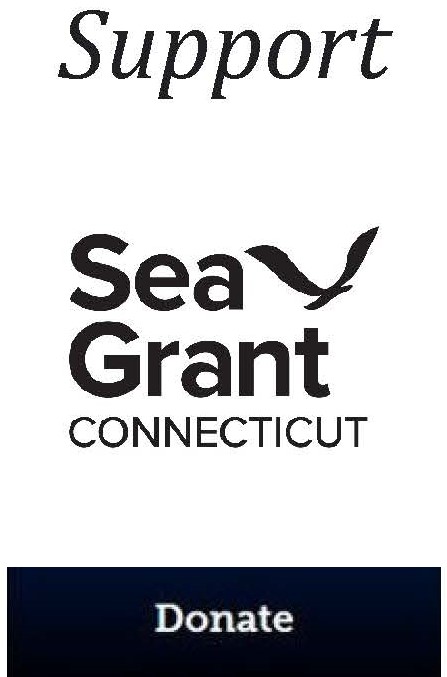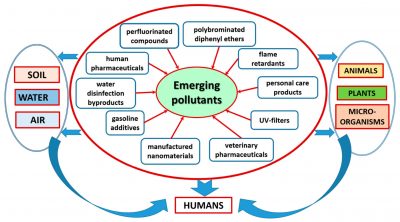- Funding
- Funded Research
- Opportunities
- Policies for Proposals
- Resources & Forms
- CTSG Fellowship Report 2020
- CTSG Strategic Plan 2018-2023 in PDF
- Integrating Education/Outreach in Your Proposal
- Progress/Final Report Form
- Progress/Final Report Form (Arts Grant)
- Policy Guidelines for No-Cost Extension Requests
- 90-2 form
- 90-4 form
- Budget Justification Guidance
- Sample Budget Justification
- Full Proposal Data Management Plan Form
- DMP Completion Form
- Connecticut Sea Grant logo
- New researcher orientation meeting
- CTSG Summer Undergraduate Research Fellowship Application Summary Form
A list of research projects funded by CT Sea Grant can be found here.
Research Funded by CT Sea Grant Omnibus 2024-2026
-
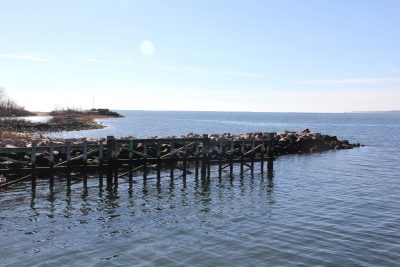
Long Island Sound at New Haven harbor “Leveraging sediment addition experiments across the Long Island Sound to examine medium-term ecosystem responses,” led by UConn Associate Professor Beth Lawrence, and co-led by UConn colleagues Ashley Helton, Chris Elphic and Connecticut Department of Energy and Environmental Protection Research Scientist Min Huang. The project will assess 170 experimental plots in four tidal marshes situated along the Connecticut coast which have received sediment additions to help maintain them in the face of rising sea levels. The plots will be measured to determine changes in plant biomass and greenhouse gas exchange. The resulting information will be used to inform coastal management and promote more resilient coastlines.
- “Oyster aquaculture associated with eelgrass habitat—maybe we can get along after all,” led by UConn Professor Craig Tobias and co-led with Jamie Vaudrey, research coordinator of the Connecticut National Estuarine Research Reserve. The researchers will grow oysters in submerged cages within eelgrass beds to assess the impact of this activity on the growth of the eelgrass and shellfish. They hope to demonstrate that restoration of eelgrass beds, which provides critical habitat for marine life in the Sound, can occur in tandem with oyster aquaculture, which improves water quality in the estuary.
- “Quantifying larval connectivity patterns and variability among natural oyster beds along the Connecticut coast,” led by UConn professors Michael Whitney and Catherine Matassa. The researchers plan to create a model showing how oyster larvae travel from spawning areas in the Housatonic River to natural shellfish beds in the Sound near Bridgeport and Stratford, which are important sources of seed oysters for commercial shellfish farmers. The project will also assess larval transport to other beds offshore from Milford, Bridgeport-Fairfield, Norwalk and Greenwich, and examine factors which influence year-to-year variability in the pathways. The results will be shared with regulators, managers, educators and other researchers.
- “Understanding the urban plastic litter cycle to optimize management and prevent export of marine debris,” led by Yale University Professor Gaboury Benoit in partnership with the Mill River Watershed Association in New Haven, supports goals of the Marine Debris Action Plan for Long Island Sound. The project will document the life cycle of litter, identifying all the places where plastic litter accumulates in the watershed, which flows directly into the Sound. The researchers will track how rapidly the litter moves and is degraded along the way, characterizing the kinds of plastic and their sources. The information will be used to determine the most efficient way to manage plastic litter and reduce the amount entering the estuary.
- “A first comprehensive evaluation of black sea bass diets in Long Island Sound,” led by UConn Associate Professor Hannes Baumann, and co-led with UConn colleagues Catherine Matassa and Paola Batta-Lona, and Kurt Gottschall of CT DEEP, will analyze the stomach contents of a fish population that is expanding rapidly in the Sound with warming water temperatures. The researchers plan to collect samples from 700 black sea bass caught in CT DEEP trawl surveys, and 300 from recreational fishermen on the Black Hawk charter boat in Niantic. The results will be used to assess the impact of growing numbers of black sea bass on food webs in the Sound and elsewhere in New England and shared with state and regional fisheries managers.
- “Barriers to career pursuits of Black, Indigenous and People of Color in the environmental workforce,” led by UConn Associate Professor Anita Morzillo in collaboration with Laura Cisneros, assistant extension professor at UConn. The project seeks to understand the challenges faced by underserved and underrepresented students in pursuing careers in the natural sciences. To do so, the researchers will provide watershed science lessons, activities and interactions with environmental professionals to more than 200 students in three college experience programs, then survey them about their motivations, obstacles, inspirations, pivotal events and other factors that influence their decisions about environmental careers. The findings will be used to develop strategies to diversify the environmental workforce and better address the challenges of climate change.
Currently Funded LISS Research (2023-2025)
- “Testing the effects of vegetation on saltmarsh ecology, services and restoration success: from microbial ecology and biogeochemistry to wildlife conservation,” will be led by UConn professors Christopher Elphick, Beth Lawrence and Ashley Helton, along with Blaire Steven of the CT Agricultural Experiment Station and Min Huang of the CT Department of Energy and Environmental Protection. By creating sediment mounds of varying elevations planted with various species at different densities at Great Meadow Marsh in Stratford, the researchers seek to develop an interdisciplinary understanding of how marsh restoration efforts impact the functioning of these ecosystems and their value for wildlife.
- “Tracking pathogen pathways and fecal bacteria patterns for public beaches suffering with poor water quality grades and closures,” will be led by UConn Professor Michael Whitney with Peter Linderoth of Save the Sound. The researchers will analyze patterns of fecal indicator bacteria in water samples from Green Harbor Beach in New London and Rocky Neck State Park in East Lyme. Because of high bacteria levels, these two public beaches are among the most frequently closed or under swim advisories in the state of Connecticut. The work will include efforts to identify bacteria pathways and public outreach about water quality issues.
- “Assessing temperature mediation of PFAS impacts on coastal fish fitness to inform environmental management,” is being led by professors Maria Rodgers of North Carolina State University and Jessica Brand, Daniel Bolnick, Kat Milligan-McClellan and Milton Levin of UConn. The researchers will examine concentrations of PFAS (poly- and per-fluoroalkyl substances) at different water temperatures in fish populations downstream from the outfalls of public sewage treatment plants. The results will quantify how fish can be expected to respond to exposure to these “forever chemicals” in the Sound over the next five decades.
- “Assessing the impacts of warming and planting strategy on the resilience of restored salt marshes to improve restoration efficacy,” will be led by Sarah Crosby of The Maritime Aquarium at Norwalk, along with Randall Hughes and Nicole Kollars of Northeastern University, Nicole Spiller of Harbor Watch and Earthplace, and LaTina Steele at Sacred Heart University. By enclosing sections of salt marshes within open chambers to increase interior temperatures, the researchers will assess the expected effects of warmer temperatures associated with climate change. The work will include plantings of southern-sourced marsh grass (Spartina) strains to determine impacts on future resilience, and an examination of the genetic mixing of these salt marsh strains to enhance the success of restoration efforts.
- “Using geohistorical baselines to assess responses of benthic macroinvertebrate communities to the nitrogen TMDL management intervention in Long Island Sound,” is directed by Gregory Dietl of the Paleontological Research Institution. Scientists will look at the remains of mollusks buried beneath the seafloor to understand past ecological conditions in the Long Island Sound (LIS). The molluscan geohistorical record could provide location-specific information about levels of nitrogen relevant for decades-long time periods that is not available from any other source.
- “Coupled prediction of residential fertilizer use and nitrogen loads to Long Island Sound: An integrated targeting tool for nitrogen-reduction behavior change campaigns,” is led by Robert Johnston of Clark University, along with David Dickson and Jamie Vaudrey of the University of Connecticut, David Newburn of the University of Maryland, Qian Lei-Parent of UConn, and Haoluan Wang of the University of Miami. This project will use a survey of households to predict residential fertilizer lawn use for the coastal counties and municipalities across the LIS watershed. A model combining this information with water quality data will be used to inform prospective behavior-change campaigns to identify and prioritize the areas or types of households that would have the greatest impact on reducing nitrogen from lawn fertilizer and its impact on the Sound.
- “Actionable satellite water-quality data products in LIS for improved management and societal benefits,” is headed by Maria Tzortziou of the City College of New York, along with Joaquim Goes of Columbia University and Melanie Abecassis of the University of Maryland College Park. Human-caused climate change as well as other anthropogenic factors can intensify harmful algal blooms (HABs) in the LIS. Observations of the entire ecosystem, over different seasons and across a range of conditions, including during extreme weather events, can be obtained from satellite data. This work will provide actionable information for water resource management, policy, and decision-making.
- “Evaluating changes in suitable habitat and distribution of cold- and warm-adaptive fish species in a changing Long Island Sound to inform ecosystem-based management,” is led by Yong Chen of Stony Brook University, along with Kurt Gottschall of the Connecticut Department of Energy and Environmental Protection, Kim McKown, and John Maniscalco, at New York State Department of Environmental Conservation. Conditions in the LIS have been shifting due to climate change, affecting water temperature, acidity, oxygen levels, and incidence of HABs. The scientists will evaluate these shifting conditions on the distributional changes of warm-adapted and cold-adapted species of fish in the Sound.
- “Equitable access to Long Island Sound waterfront and beaches through on-demand mobility,” is led by Anil Yazici and Elizabeth Hewitt of Stony Brook University. Some communities on Long Island do not have the mobility means to use and appreciate the LIS waterfront. Project leaders are designing and piloting on-demand shuttles that will facilitate equitable public access to the LIS waterfront. The team will survey users of the shuttle service to identify changes in attitudes toward the LIS environment.
The press release announcing the awards can be found here.
Research Funded by CT Sea Grant Omnibus 2022-2024
- “Copepod Adaptation to Climate Change: No Free Lunch?” led by Hans Dam, UConn Dept. of Marine Sciences, and Michael Finiguerra, UConn Dept. of Ecology and Evolutionary Biology. Building on earlier research on the copepod species Acartia tonsa, this research examines the costs of adaptation to future climate conditions that can constrain copepod evolutionary rescue, limit population resilience and consequently reduce fisheries and aquaculture yields. Population fitness is being tested after prolonged exposure to 100 generations of ocean warming, ocean acidification and combined warming and acidification conditions. The research is also testing if adaptation to these climate change conditions diminishes population fitness, and whether there are differences in adaptation costs among ocean warming, ocean acidification and combined warming and acidification conditions. Tests are also being conducted to discover any hidden costs of adaptation to the three climate change conditions manifested as increased susceptibility to toxic phytoplankton and reduced thermal tolerance.
- “Restoration of Kelp Forests and Associated Ecosystem Services in Long Island Sound,” led by Sean Grace, Southern Connecticut State University, and Colette Feehan, Montclair State University. The use of "green gravel" as a kelp forest restoration technique is being tested on degraded rocky reefs in Long Island Sound that were formerly dominated by kelp forests but now dominated by algal turfs, to restore the kelp habitat and associated ecosystem services. A partnership with kelp aquaculture farmers is being employed by incorporating locally developed and validated commercial
as a kelp kelp seed production methods into the project. Local high school students and teachers from the Bridgeport Regional Vocational Aquaculture School and Project Oceanology are also participating in the research as an educational project. The goal of the project is to provide a “proof of concept” for the green gravel technique in Long Island Sound that can be upscaled in the future to restore kelp forests along the degraded Sound coastline. To accomplish broad kelp forest restoration goals, the “green gravel” technique must be piloted locally to establish the conditions under which it will be most effective. - “Toward a Deeper Understanding of Human Connections with Ocean Environments: Ocean Identity (OI) as a Novel Construct, Research Instrument, and Assessment Tool,” led by Miriah Russo Kelly, Southern Connecticut State University; Jo-Marie Kasinak, Sacred Heart University; and Emma McKinley, Cardiff University. This research seeks to create a model for measuring the construct of ocean identity by providing practical, relevant and timely tools for environmental organization partners. Researchers will first survey academic literature pertaining to the construct of ocean literacy, and then design an instrument to measure it. Data will be collected broadly to validate the instrument and include analysis of differences in race, gender and age. The data will be used for an additional phase of the research that will use Project Limulus as a case study platform for implementing the survey in a way that is appropriate for informal educational settings. The project will also include development of a toolkit that could be used by many organizations to provide informal engagement, outreach and education around ocean issues. In developing a validated, reliable instrument for measuring ocean identity, the researchers seek to establish effective ways for measuring complex human-ocean connections.
- "Increasing Sea Bass Abundance in Long Island Sound: A Local or Broader Regional Phenomenon?" Led by Hannes Baumann, UConn Dept. of Marine Sciences, and Deborah Pacileo and Jacqueline Benway, both of the CT Dept. of Energy and Environmental Protection, this project is addressing questions raised by the sharply rising abundance of black sea bass in Long Island Sound trawl surveys. The first question is whether the Sound could be a particularly suitable ecosystem for an especially rapid invasion of this warm-water adapted meso-predator. To answer this question, researchers are collecting an analyzing age-structure data for black sea bass from the Sound for length, growth and sex, analyzing historical data and comparing abundance trends from other regions. This project is helping to fill a critical gap in Sound-specific black sea bass age data. This serves the important work of developing accurate updated stock assessments needed by marine fisheries regulators. The relationship of environmental factors such as salinity and temperature to abundance is also being explored, and information on survey efforts in other regions is being gathered and analyzed for indications of abundance trends.
- “Risk Averse or Risk Enduring? Understanding the Relationship between Long Island Sound Communities and Flooding to Support Equitable Risk Mitigation Planning,” led by James Knighton, UConn Dept. of Natural Resources and the Environment. To advance equitable flooding solutions across Long Island Sound, this research is using socio-environmental models, demographic data and historical records from the National Flood insurance Program (NFIP) to characterize the attitudes and behaviors relevant to a community’s strategy for flood risk mitigation and determine barriers to NFIP participation. Researchers are studying seven Long Island Sound communities protected by coastal surge barriers to determine whether the protection that these barriers provide from moderate floods leads to increased risk when communities relax precautionary behaviors. The project will also develop predictions on how community behaviors might shift in response to future storm conditions of sea level rise combined with more frequent high surge events. This work will be complemented with an examination of the hypothesis that more frequent flooding will drive increased awareness and more community desire to participate in flood protection programs.
- “Assessment of PFAS Food Web Uptake in Priority Shellfish Areas: The Roles of Nutrient Status and Trophic Transfer," led by Christopher Perkins, UConn Center for Environmental Science and Engineering, and Jessica Brandt, UConn Dept. of Natural Resources and the Environment. This research will address the lack of information about bioaccumulation of per- and polyfluoroalkyl substances (PFAS) in coastal Long Island Sound species, in particular shellfish harvested for human consumption and phytoplankton that form the basis of the Sound’s food web. The study seeks to advance understanding of how nutrient-contaminant interactions mediate PFAS accumulation and trophic transfer to shellfish in coastal food webs by investigating how phytoplankton responses to shifts in nutrient status influence the magnitude of PFAS uptake by these primary producers at the base of the LIS food web, which are direct sources of exposure to CT shellfish species. The research will consist of a baseline assessment of PFAS contaminants in shellfish from regulated beds; an assessment of variations in phytoplankton and shellfish PFAS concentrations; and determination of the relationship between phytoplankton PFAS concentrations and concentrations in blue mussels and wild-caught and farmed shellfish.
The press release announcing these awards can be found here.
Recent Posts
- Eclipse event a fitting way to mark Community Science Month
- On Earth Day, hold both hope and lament as you reassess your role
- Microplastic ‘hot spots’ identified in Long Island Sound
- 1st national drinking water standard to protect 100M people from PFAS pollution
- Avery Point EcoHusky Club to host Earth Day celebration
